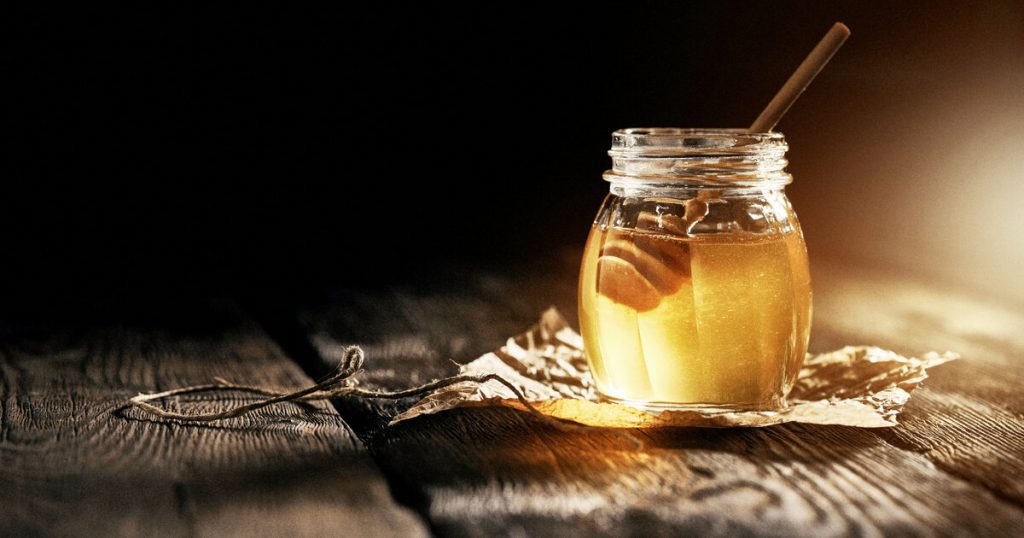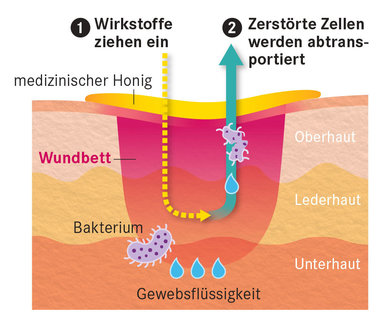
World Bee Day: Sweet Gold | Pharmacy Journal
Says Professor Karsten Munstead, chief gynecologist at the Ortenau Clinic Offenburg-Kehl – and beekeeper for 40 years. “For me, nothing is better than standing in front of an open beehive, and seeing the bees do well.”
Every now and then the doctor deals with bees in his daily work. Of course, the six-legged friends don’t even beat the operating room, but their honey is used in some patients. Honey has now been shown to be effective in treating wounds
Like when boiling jam
A Monstead gynecologist remembers the first time honey was used as a therapeutic agent in another clinic. At that time he was treating a patient with advanced stage breast cancer. The patient developed a wound tumor that smelled foul. Although the wound is rinsed daily with various solutions, the smell remains. A heavy burden for the patient.
“At the time, I had just read a study on honey in wound care and suggested that you try it,” says Münstedt. At first, some colleagues smiled at the idea, but only two days later it had an effect: “Honey absorbed the wound fluid. The bacteria that produced the bad smell were gone.” The patient could not defeat the cancer, but her quality of life improved and she was able to see her relatives again.
Meanwhile, honey has become well established in healing wounds and has proven antibacterial effect. The various mechanisms play a role here. Honey is made up of 80 percent sugar. It removes water from the wound and bacteria in it. “It dries up and dies,” the expert explains. The same principle is used with jam. “You add a lot of sugar to the fruit so that it does not tolerate the bacteria in it. That is why it does not spoil the jam.”

Honey draws water from the wound. It consists of 80% sugar and 20% water. On the other hand, the wound contains a lot of fluid. To compensate for the difference in concentration, water and bacteria in the wound are removed
Lots of antibacterial substances in honey
Dr. Birgit Lichtenberg Krag, head of the honey analysis department at the State Beekeeping Institute Hohn Neuendorf near Berlin. “From a chemical point of view, honey is an acid,” the expert explains. You don’t notice this due to its high sugar content. However, its pH ranges between 3.5 and 4.5. No bacteria will grow in this acidic environment.
Additionally, certain types of honey contain a large amount of the enzyme glucose oxidase. With regard to wound fluid, it converts glucose – one of the main sugars in honey – into gluconic acid. “This releases hydrogen peroxide, which acts as a disinfectant,” explains Lichtenberg-Krag.
The fact that honey combats bacteria applies to all types. However, medicinal honey can only be used in treating wounds: Manuka honey specially prepared from New Zealand. Compared to other honeys, it contains an additional ingredient: methylglyoxal. “It supports the anti-bacterial effect,” Lichtenberg-Kraag explains.
In addition, honey offers another benefit in treating wounds: it ensures more gentle wound healing and the absence of large scars. “The acid in honey stops certain enzymatic activities of the bacteria, so fewer tissues die.”
In total, honey contains about 200 different substances. These include secondary plant substances such as flavonoids, which promote healing and have an anti-inflammatory effect. The mixture of substances varies from honey to honey. “This is why the bacteria have not yet developed any resistance, that is, resistance to honey,” the expert explains. Great advantage over antibiotics.
Use honey for colds?
So honey is an effective way to treat wounds. But what about the common cold? Milk and honey, for example, is a home remedy for itchy throat. “There are hardly any meaningful studies on this topic,” says Münstedt. On the other hand, if it is only about honey, the study case is better – at least with children. “A meta-study showed that children with the common cold cough slightly less and sleep better if they consumed a spoonful of honey in the evening,” says Münstedt. Honey lies as a film on the mucous membranes in the throat and works there against infections. If you consume honey on bread or diluted in tea, this effect is lost.
Since honey is primarily composed of sugar, it should only be consumed in small quantities. Otherwise, the risk of obesity and the diseases that arise from it increases. Honey is completely taboo for children under one year old. Although it cannot contain bacteria, it can contain spores of them. Since babies’ immune systems are still immature, spores can cause severe poisoning for them.
Münstedt cautions against exaggerated promises of salvation – recently, for example, the specialist journal BMJ Evidence-Based Medicine published a review by researchers at the University of Oxford. Accordingly, honey works better than upper respiratory tract infection medications. Many media picked up this news, but in the professional world, the study was torn apart by biases, incorrect calculations and comparisons. “This study is completely questionable,” says Doctor Münstedt.
Allergy risks with honey mixtures
Lichtenberg-Kraag is generally cautious about honey’s effects: “Its many ingredients can also have a positive effect on a cold.” For example, linden honey contains parts of an essential oil. However, the effect of honey has been proven only in treating wounds.
Beekeepers, for example, are not permitted to advertise the health benefits of their product. The expert explains: “Honey is a food, not a medicine.” However, some of the labels say things that are full of adventure. Caution is also advised with self-blended honey creations. Sometimes other bee products such as propolis are added to it. Lichtenberg-Kraag said many people will be allergic to this.
On the other hand, allergies to pure honey are very rare: “The pollen content in honey is only about 0.02 to 0.05 percent of the ingredients.” Therefore, people with hay fever are not afraid.
Is honey contaminated with pesticides? According to the Federal Center for Nutrition the quality of German honey is good: www.bzfe.de

“Coffee trailblazer. Social media ninja. Unapologetic web guru. Friendly music fan. Alcohol fanatic.”
